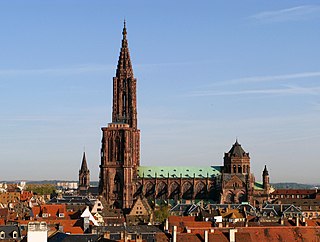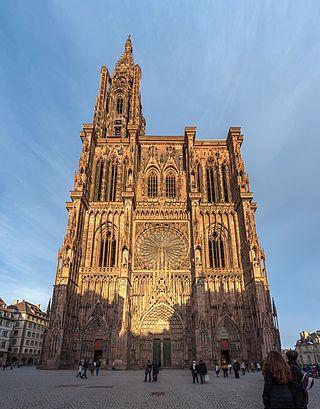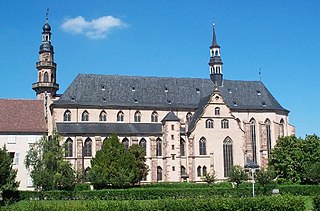This article may be expanded with text translated from the corresponding article in French. Click [show] for important translation instructions.
|
Werner I, Bishop of Strasbourg was bishop of Strasbourg. He died on 28 October 1028. [1]
This article may be expanded with text translated from the corresponding article in French. Click [show] for important translation instructions.
|
Werner I, Bishop of Strasbourg was bishop of Strasbourg. He died on 28 October 1028. [1]
Zorn is a family name of German origin meaning "wrath". Historically, it was predominantly strong in German influenced cities such as Strasbourg, Kempten, Innsbruck, and Würzburg. Today, the surname Zorn can be frequently found in Bavaria, Baden-Württemberg, Rheinland-Pfalz, and Thüringen.
Year 1001 (MI) was a common year starting on Wednesday of the Julian calendar. It is the first year of the 11th century and the 2nd millennium.

Strasbourg is the prefecture and largest city of the Grand Est region of eastern France and the official seat of the European Parliament. Located at the border with Germany in the historic region of Alsace, it is the prefecture of the Bas-Rhin department.

Strasbourg Cathedral or the Cathedral of Our Lady of Strasbourg, also known as Strasbourg Minster, is a Catholic cathedral in Strasbourg, Alsace, France. Although considerable parts of it are still in Romanesque architecture, it is widely considered to be among the finest examples of Rayonnant Gothic architecture. Architect Erwin von Steinbach is credited for major contributions from 1277 to his death in 1318, and beyond through his son Johannes von Steinbach, and his grandson Gerlach von Steinbach, who succeeded him as chief architects. The Steinbachs's plans for the completion of the cathedral were not followed through by the chief architects who took over after them, and instead of the originally envisioned two spires, a single, octagonal tower with an elongated, octagonal crowning was built on the northern side of the west facade by master Ulrich von Ensingen and his successor, Johannes Hültz. The construction of the cathedral, which had started in the year 1015 and had been relaunched in 1190, was finished in 1439.

Molsheim is a commune and a subprefecture in the Bas-Rhin department in Grand Est in north-eastern France. The total population in 2017 was 9,312. Molsheim had been a very fast-growing city between the French censuses of 1968 and 1999, passing from 5,739 to 9,335 inhabitants, but this increase came to a noticeable halt since. The urban unit of Molsheim had 26,925 inhabitants in 2017, from 16,888 in 1968. Molsheim is part of the metropolitan area of Strasbourg.
Ungerer is a surname. Notable people with the surname include:

Sarrebourg is a commune of northeastern France.

Habsburg Castle is a medieval fortress located in what is now Habsburg, Switzerland, in the canton of Aargau, near the Aar River. At the time of its construction, the location was part of the Duchy of Swabia. Habsburg Castle is the original seat of the House of Habsburg, which became one of the leading imperial and royal dynasties in Europe. It is listed as a Swiss heritage site of national significance.

Schirmeck is a commune in the Bas-Rhin department in Grand Est in north-eastern France.
Herman II was a member of the Conradine dynasty. He was Duke of Swabia from 997 to his death. In 1002, Herman unsuccessfully attempted to become king of Germany.
Werner von Habsburg may refer to:

The Prince-Bishopric of Strasburg was an ecclesiastical principality of the Holy Roman Empire from the 13th century until 1803. During the late 17th century, most of its territory was annexed by France; this consisted of the areas on the left bank of the Rhine, around the towns of Saverne, Molsheim, Benfeld, Dachstein, Dambach, Dossenheim-Kochersberg, Erstein, Kästenbolz, Rhinau, and the Mundat. The annexations were recognized by the Holy Roman Empire in the Treaty of Ryswick of 1697. Only the part of the state that was to the east of the Rhine remained; it consisted of areas around the towns of Oberkirch, Ettenheim, and Oppenau. This territory was secularized to Baden in 1803.

Radbot, Count of Klettgau was Graf (Count) of the county of Klettgau on the High Rhine in Swabia. Radbot was one of the progenitors of the Habsburg dynasty, and he chose to name his fortress Habsburg.

Achenheim is a commune in the Bas-Rhin department and Grand Est region of north-eastern France.

The Palais Rohan in Strasbourg is the former residence of the prince-bishops and cardinals of the House of Rohan, an ancient French noble family originally from Brittany. It is a major architectural, historical, and cultural landmark in the city. It was built next to Strasbourg Cathedral in the 1730s, from designs by Robert de Cotte, and is considered a masterpiece of French Baroque architecture. Since its completion in 1742, the palace has hosted a number of French monarchs such as Louis XV, Marie Antoinette, Napoleon and Joséphine, and Charles X.

The Archdiocese of Strasbourg is a Latin Church ecclesiastical territory or archdiocese of the Catholic Church in France, first mentioned in 343 AD.

The Dancing Plague of 1518, or Dance Epidemic of 1518, was a case of dancing mania that occurred in Strasbourg, Alsace, in the Holy Roman Empire from July 1518 to September 1518. Somewhere between 50 and 400 people took to dancing for weeks.
Valentin Krautwald (1465–1545) was a German religious reformer, lector of theology at Liegnitz, and colleague of Caspar Schwenckfeld.
William I was bishop of Strasbourg from 1028 or 1029. Being a son of Otto of Worms, the first Salian duke of Carinthia, William was the uncle of Conrad II, Holy Roman Emperor who appointed him to the bishopric. His tenure was uneventful.